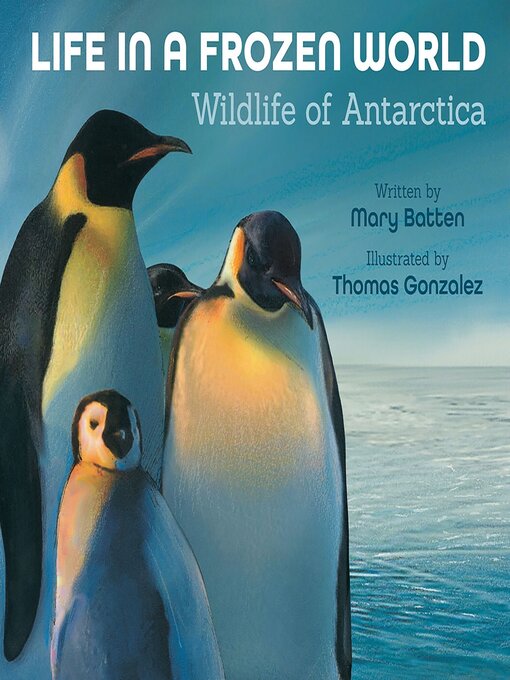Antarctica is one of the most extreme environments on Earth—the coldest, windiest, driest place on the planet. This frozen continent affects weather, ocean currents, and sea levels all over the Earth.
From award-winning, experienced nature writer Mary Batten comes a remarkable nonfiction picture book that plumbs the mysteries of this hostile environment. With clear, engaging language, Batten explores fascinating questions that scientists the world over have been researching, such as how a wide variety of wildlife can survive in this frigid environment and how Antarctica might be the key to long-standing questions about the Earth and climate change.
New York Times bestselling illustrator Thomas Gonzalez brings Batten's text to life with detailed, realistic paintings.
An ideal resource for young science lovers and educators, this informative volume is perfect for classroom units on climate change, conservation, ecology, oceanography, and more.
-
Creators
-
Series
-
Publisher
-
Release date
November 1, 2020 -
Formats
-
OverDrive Read
- ISBN: 9781682632642
-
PDF ebook
- ISBN: 9781682632642
- File size: 265853 KB
-
-
Languages
- English
-
Levels
- Lexile® Measure: 1130
- Text Difficulty: 8-9
-
Reviews
-
School Library Journal
Starred review from September 1, 2020
Gr 3-5-This informative introduction to earth science details how animals live and thrive in Antarctica. Batten presents many fascinating examples of how penguins, seals, and icefish adapt to this challenging climate. Their survival depends on the availability of krill, small shrimplike crustaceans that are a source of food. Krill are uniquely adapted to survive in Antarctica because they can shrink themselves and go without food for long periods of time. Whales, too, have traits that assist their survival. These warm-blooded mammals migrate to other places during the coldest seasons. They have a layer of blubber under their skin that keeps them warm, and they can regulate their body temperature. The text also discusses the consequences of climate change. Topics include how scientists collect ice cores to learn about changing conditions, scientific research under the water, the impact of melting ice on animals, and the melting of ice shelves that surround Antarctica. The text makes a compelling case for understanding and caring about Antarctica. Gonzalez's illustrations provide an intriguing depiction of the setting. VERDICT A superb choice for students who are studying animal adaptation and how climate change impacts Antarctica. The well-researched text and captivating illustrations work well to convey the importance of conservation.-Myra Zarnowski, City Univ. of New York
Copyright 2020 School Library Journal, LLC Used with permission.
-
Kirkus
September 1, 2020
Although the southernmost continent is covered with ice all year round, wildlife still thrives in Antarctica--but the ecosystem there is threatened. Batten worked with the Cousteau Society campaign against mineral exploitation in Antarctica in 1990. Her continued fascination with this relatively mysterious world, which has no permanent human population, is evident in her depiction of the life that does thrive there. Her descriptions are clear, concise, and interesting, whether she's discussing forests of kelp, pastures of phytoplankton, and swarms of krill; the fish, whales, penguins, and seals at the top of the food chain; or the underwater invertebrates who live long and often grow to gigantic proportions. Her text is relatively substantial for a picture book, and it's set against a backdrop of gorgeous Antarctic scenes created by Gonzalez using pastel, colored pencils, and airbrush. The animals are recognizable; the scenery is magnificent. After presenting the resident wildlife, the author introduces humans--scientists taking advantage of Antarctica's protected status and sunlit summers for research of all kinds, including studying the effects of Earth's changing climate. She describes the changes on the plant and animal life and the loss of sea ice, which also threatens the rest of the world. "Scientists estimate the melting of Antarctica's land ice will lead to a rise in sea level of between 3 and 16 inches...by 2100." Sobering news in a handsome package. (map, further facts, author's note, glossary, acknowledgments, selected bibliography) (Nonfiction. 7-10)COPYRIGHT(2020) Kirkus Reviews, ALL RIGHTS RESERVED.
-
Booklist
November 1, 2020
Grades 3-5 Transporting readers to Antarctica, this beautifully illustrated book introduces the complex ecosystem on the continent and in the sea surrounding it. Green plants are the most basic link in most food chains, but is this cold, dry, windy continent an exception to the rule? As Batten vividly describes, photosynthesis here takes place in the ocean, where seaweed grows like "a forest of giant algae," and phytoplankton, like "an upside-down pasture of tiny green plants," cling to the underside of the sea ice. They become food for krill, a keystone species in the Antarctic region. The book also notes that 30 nations carry out scientific research on the continent, a topic leading directly into climate change and its effects on Antarctica and the world. Batten presents well-researched and clearly written text that includes enough detail to engage readers without overwhelming them. Created with pastel, colored pencil, and airbrush, Gonzalez's double-page pictures present vivid scenes of windswept ice, dramatic skies, and seas teeming with life. This inviting volume provides a lively introduction to Antarctica and its unique ecosystem.COPYRIGHT(2020) Booklist, ALL RIGHTS RESERVED.
-
Formats
- OverDrive Read
- PDF ebook
subjects
Languages
- English
Levels
- Lexile® Measure:1130
- Text Difficulty:8-9
Loading
Why is availability limited?
×Availability can change throughout the month based on the library's budget. You can still place a hold on the title, and your hold will be automatically filled as soon as the title is available again.
The Kindle Book format for this title is not supported on:
×Read-along ebook
×The OverDrive Read format of this ebook has professional narration that plays while you read in your browser. Learn more here.



